I'd like to have an animation where some lines collapse into points, which are the mean value, to demonstrate that the lines can be summarised by the mean value.
Something like this.
First, set up the data, and the line plot:
library(tidyverse)
# remotes::install_github("njtierney/brolgar)
# library(brolgar)
# h_cut <- sample_n_keys(heights, 5) %>%
# mutate(type = "raw")
#
# datapasta::dpasta(h_cut)
h_cut <- tibble::tribble(
~country, ~year, ~height_cm, ~continent, ~type,
"Bolivia", 1890, 163.594, "Americas", "raw",
"Bolivia", 1900, 162.45, "Americas", "raw",
"Bolivia", 1930, 162.5, "Americas", "raw",
"Bolivia", 1940, 163.4, "Americas", "raw",
"Bolivia", 1950, 162.482, "Americas", "raw",
"Bolivia", 1960, 163.182, "Americas", "raw",
"Bolivia", 1970, 163.886, "Americas", "raw",
"Bolivia", 1980, 164.191, "Americas", "raw",
"Bolivia", 1990, 168.1, "Americas", "raw",
"Bolivia", 2000, 168.7, "Americas", "raw",
"Ethiopia", 1860, 169.3, "Africa", "raw",
"Ethiopia", 1880, 167.461, "Africa", "raw",
"Ethiopia", 1910, 161.451, "Africa", "raw",
"Ethiopia", 1920, 166.636, "Africa", "raw",
"Ethiopia", 1930, 167.27, "Africa", "raw",
"Ethiopia", 1940, 168.5, "Africa", "raw",
"Ethiopia", 1950, 166.823, "Africa", "raw",
"Ethiopia", 1960, 167.512, "Africa", "raw",
"Ethiopia", 1970, 167.49, "Africa", "raw",
"Ethiopia", 1980, 167.253, "Africa", "raw",
"Georgia", 1840, 165.5, "Asia", "raw",
"Georgia", 1860, 163, "Asia", "raw",
"Georgia", 1890, 164.26, "Asia", "raw",
"Georgia", 2000, 173.2, "Asia", "raw",
"Paraguay", 1900, 165.615, "Americas", "raw",
"Paraguay", 1930, 165.363, "Americas", "raw",
"Paraguay", 1990, 172.6, "Americas", "raw",
"Spain", 1740, 163.3, "Europe", "raw",
"Spain", 1750, 163.6, "Europe", "raw",
"Spain", 1760, 163.2, "Europe", "raw",
"Spain", 1770, 164.3, "Europe", "raw",
"Spain", 1780, 163.3, "Europe", "raw",
"Spain", 1830, 161, "Europe", "raw",
"Spain", 1840, 163.7, "Europe", "raw",
"Spain", 1850, 162.5, "Europe", "raw",
"Spain", 1860, 162.7, "Europe", "raw",
"Spain", 1870, 162.6, "Europe", "raw",
"Spain", 1880, 163.9, "Europe", "raw",
"Spain", 1890, 164, "Europe", "raw",
"Spain", 1900, 164.6, "Europe", "raw",
"Spain", 1910, 165.1, "Europe", "raw",
"Spain", 1920, 165.6, "Europe", "raw",
"Spain", 1930, 165.2, "Europe", "raw",
"Spain", 1940, 166.3, "Europe", "raw",
"Spain", 1950, 170.8, "Europe", "raw",
"Spain", 1960, 174.2, "Europe", "raw",
"Spain", 1970, 175.2, "Europe", "raw",
"Spain", 1980, 175.6, "Europe", "raw"
)
ggplot(h_cut,
aes(x = year,
y = height_cm,
colour = country)) +
geom_line() +
theme(legend.position = "bottom")

Then, show the points
# demonstrate these lines collapsing down onto a point
h_sum <- h_cut %>%
group_by(country) %>%
summarise(height_cm = mean(height_cm)) %>%
mutate(year = max(h_cut$year),
type = "summary")
ggplot(h_sum,
aes(x = year,
y = height_cm)) +
geom_point()

These can be combined into one plot like so:
# combined:
p <- ggplot(h_cut,
aes(x = year,
y = height_cm,
colour = country)) +
geom_line() +
geom_point(data = h_sum,
aes(x = year,
y = height_cm,
colour = country))
p

Manually transition from line to points
library(gganimate)
anim <- p +
transition_layers(keep_layers = FALSE) +
enter_grow() +
exit_shrink() +
ease_aes(default = "cubic-in-out")
anim

But is there some way to make the lines shrink into the points?
h_full <- h_sum %>% full_join(h_cut)
#> Joining, by = c("country", "height_cm", "year", "type")
h_full
#> # A tibble: 53 x 5
#> country height_cm year type continent
#> <chr> <dbl> <dbl> <chr> <chr>
#> 1 Bolivia 164. 2000 summary <NA>
#> 2 Ethiopia 167. 2000 summary <NA>
#> 3 Georgia 166. 2000 summary <NA>
#> 4 Paraguay 168. 2000 summary <NA>
#> 5 Spain 166. 2000 summary <NA>
#> 6 Bolivia 164. 1890 raw Americas
#> 7 Bolivia 162. 1900 raw Americas
#> 8 Bolivia 162. 1930 raw Americas
#> 9 Bolivia 163. 1940 raw Americas
#> 10 Bolivia 162. 1950 raw Americas
#> # … with 43 more rows
p <- ggplot(h_full,
aes(x = year,
y = height_cm,
group = country,
colour = type)) +
geom_point() +
geom_line()
anim <- p + transition_states(type)
anim
#> Error in `$<-.data.frame`(`*tmp*`, ".id", value = c(1L, 1L, 1L, 1L, 1L, : replacement has 250 rows, data has 5
Created on 2019-07-25 by the reprex package (v0.3.0)
